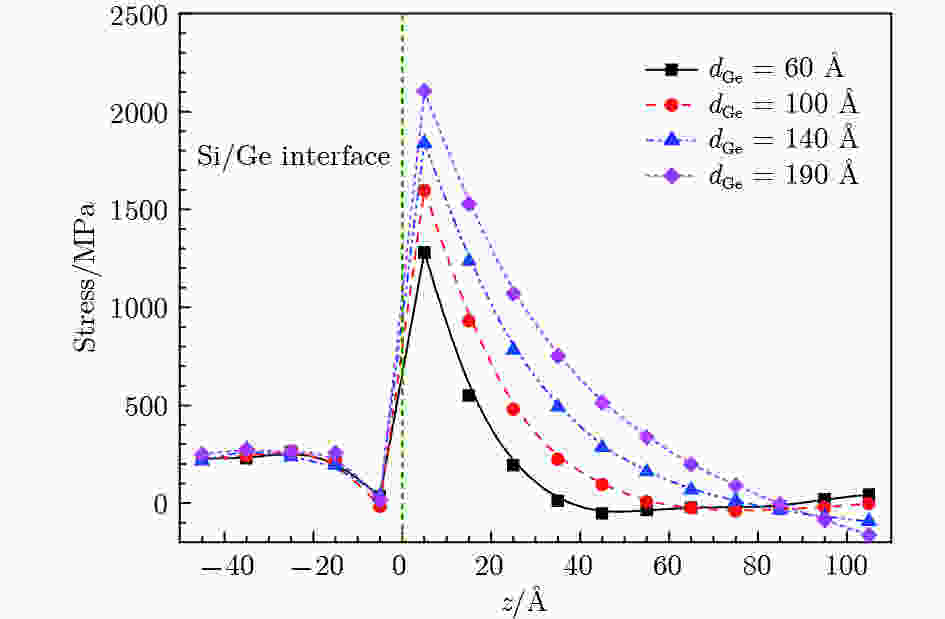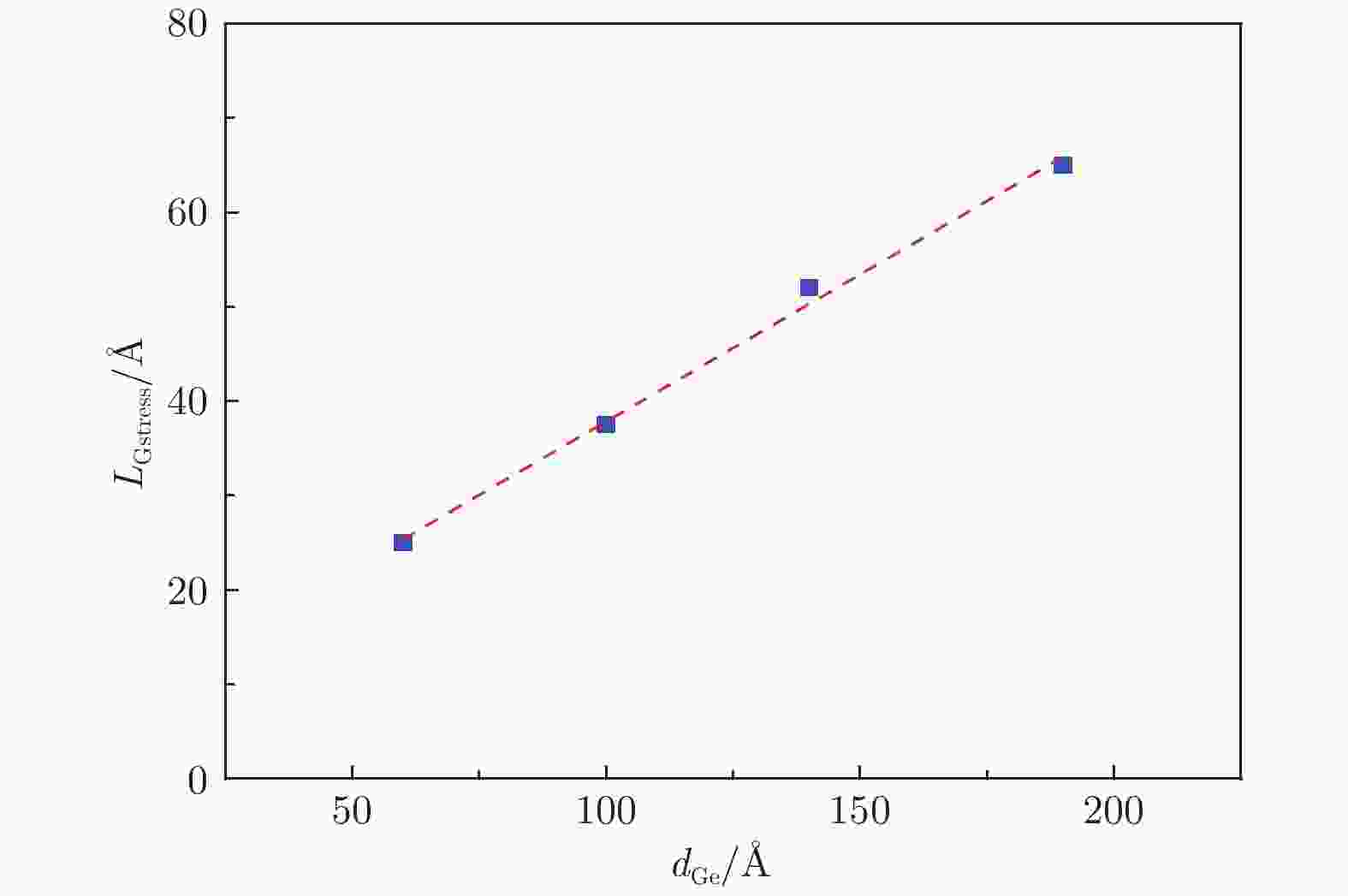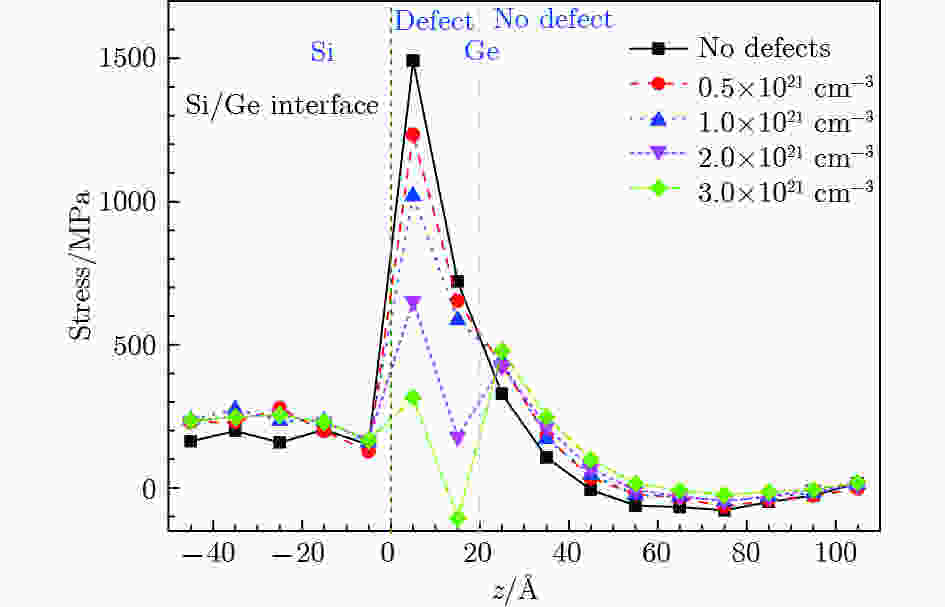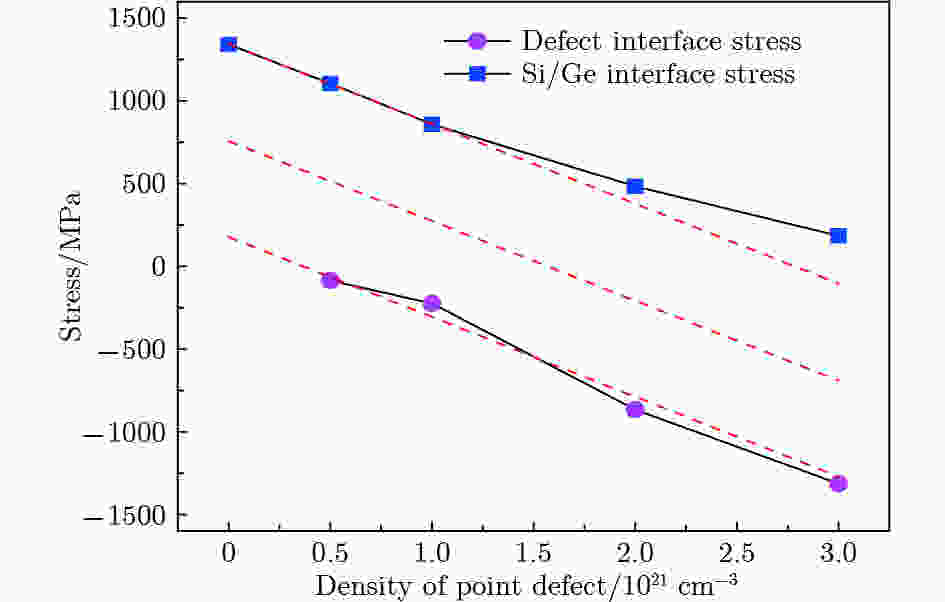全文HTML
--> --> -->然而, Ge与Si具有很大的晶格失配(达到4.2%)和热失配, 导致Si基Ge薄膜材料一般具有很高的穿透位错密度和表面粗糙度, 不利于器件制备, 且会严重降低器件性能. 为了在Si基上生长高质量的Ge薄膜, 研究人员开发了多种工艺方法来降低位错密度和表面粗糙度, 比如: 渐变缓冲层方法[17,18]、选区外延方法[19,20]、低温缓冲层方法以及高低温两步生长方法[21?29]. 到目前为止, 高低温两步生长方法结合循环退火工艺是最常用的Si基Ge薄膜生长方法. 该方法中低温层一般采用Ge或者Ge-Si材料, 通过这种方法可以制备出位错密度低至1×106 cm?2, 表面粗糙度小于1 nm的Si基Ge薄膜[28,29].
在微观层面, 科研人员在高低温两步生长方法制备的Si基Ge薄膜材料的低温层中观察到了大量的点缺陷[25,30?32], 由此推断低温层中存在的大量点缺陷可以与位错进行作用, 吸收Ge与Si之间的失配应力能量, 降低Si和Ge之间的应力, 从而减小穿透位错密度. 但少有研究低温层对位错密度影响的理论证据, 以及失配应力受低温层的影响机制. 本文从应力角度入手, 针对低温缺陷层对Si/Ge界面失配应力影响机制开展研究, 希望能从应力层面揭示低温缓冲方法的作用本质. 基于这种思想, 采用分子动力学模拟方法, 从原子尺度上研究Si/Ge界面结构特征及应力特性, 从而揭示Si/Ge界面应力在缺陷层存在时的应力释放机制, 在此基础上建立异质材料界面应力释放模型, 为Si基异质材料生长工艺优化提供参考. 本文采用分子动力学方法模拟了不同尺度、不同缺陷密度条件下的Si和Ge界面体系应力分布, 研究了在微观下体系尺寸和缺陷密度对Si/Ge界面应力的影响规律.
Tersoff势函数重写为如下形式:

本文所涉及的所有分子动力学模拟过程均采用Lammps软件包[38]进行. 模拟过程如下.
| 参数 | Si | Ge |
| A/eV | 1.8308×103 | 1.769×103 |
| B/eV | 4.7118×102 | 4.1923×102 |
| λ/??1 | 2.4799 | 2.4451 |
| μ/??1 | 1.7322 | 1.7047 |
| β | 1.1000×10?6 | 9.0166×10?7 |
| n | 7.8734×10?1 | 7.5627×10?1 |
| c | 1.0039×105 | 1.0643×105 |
| d | 1.6217×101 | 1.5652×101 |
| h | ?5.9825×10?1 | ?4.3884×10?1 |
| R/? | 2.7 | 2.8 |
| S/? | 3.0 | 3.1 |
| 注: ${\chi _{{\rm Si} -{\rm Ge}}} = 1.00061$. | ||
表1Tersoff势函数参数[33]
Table1.Parameters of Tersoff potential function[33].
1) 建立包含Si/Ge界面结构的无缺陷一维简化界面模型, 如图1所示. 体系x-y方向采用周期性边界条件, z方向采用自然边界条件. 模拟过程中: 体系Si层x-y平面尺寸dSi = 217 ?, 满足周期性边界条件; 为了克服Si和Ge之间的晶格失配对模型的影响, Ge层在x-y方向采用自然边界条件, 同时增加一个真空层, 达到与Si层相同的尺寸, 真空层的厚度要大于20 ?, 从而可以采用相同的周期性边界条件. Ge层x-y方向尺寸分别为60, 100, 140和190 ?, 其他区域为真空层; z方向尺寸为200 ?, 其中衬底Si厚度LSi = 80 ?, Ge厚度LGe = 120 ?.
 图 1 Si/Ge界面模拟示意图
图 1 Si/Ge界面模拟示意图Figure1. Schematic diagram of simulation of Si/Ge interface.
2) 对体系进行充分弛豫, 弛豫过程为: 先升温到1100 K, 在1100 K下弛豫800 ps (1 ps = 10?12 s); 再降温到300 K, 并在300 K下弛豫500 ps; 获得接近平衡态的体系, 计算Si/Ge界面两边的应力分布. 应力计算方法[39]为: 以Si/Ge界面为零点, 10 ?为间隔, 将整个体系z方向分成若干方块, 如图2所示, 计算每一个方块内的平均应力, 以此作为该方块中心处的应力值, 分析体系在z方向的应力分布.
 图 2 Si和Ge体系应力计算示意图
图 2 Si和Ge体系应力计算示意图Figure2. Diagram of stress calculation of Si and Ge system.
3) 改变Ge在x-y方向的尺寸, 重复以上步骤, 对比Ge尺寸对Si/Ge界面应力的影响.
4) 在Si和Ge材料之间引入缺陷层(Ge), 充分弛豫后计算界面应力变化, 分析缺陷层对Si/Ge界面应力释放过程的影响机制.
在模拟过程中, Ge在x-y方向的尺寸(dGe)分别为60, 100, 140和190 ?, 引入的点缺陷密度分别为0.5×1021, 1.0×1021, 2.0×1021和3.0×1021 cm?3. 模拟过程中体系温度由Berendsen热浴法控制, 模拟时间步长取为1.0 fs (1 fs = 10?15 s).
3.1.Ge尺寸对Si/Ge界面应力分布的影响
首先对不同Ge尺寸下的Si/Ge界面应力分布进行分析, 结果如图3所示. 从图3可以看出, 应力随着远离界面而迅速降低, 表明Si/Ge界面应力主要集中在界面附近. 图 3 不同Ge尺寸下Si/Ge界面应力的变化
图 3 不同Ge尺寸下Si/Ge界面应力的变化Figure3. Variation of stress at Si/Ge interface under different sizes of Ge.
为获取Ge尺寸对Si/Ge界面应力下降速度的影响规律, 计算了不同Ge尺寸下, 应力下降到200 MPa (与模型中衬底Si的应力相当)的位置与界面的间距(LGstress), 结果如图4所示. 从图4结果可以看出, 应力下降到200 MPa的位置与界面的间距与Ge尺寸具有近似线性递增的关系, Ge尺寸越小, 越有利于界面应力的快速释放. 随着Ge尺寸的增加, Si/Ge界面应力释放速度迅速降低.
产生这一现象的内在原因是Ge在小尺寸下界面应力的释放机制. 在一维界面模型中, Ge利用边界扩展的机制来释放失配应力, 应力释放速度与边界总长度呈正比. 而界面的总应力与界面原子失配程度以及界面的面积有关, 在原子类别一定时, 界面面积越大, 界面总应力越大. 界面应力从峰值下降到200 MPa的距离与界面总应力以及应力释放速度密切相关, 总应力越大, 应力释放需要的距离越大, 而应力释放速度越大, 应力释放需要的距离越小, 如(2)式所示:
 图 4 应力下降到200 MPa的位置与界面间距LGstress与Ge尺寸的关系
图 4 应力下降到200 MPa的位置与界面间距LGstress与Ge尺寸的关系Figure4. Relationship between distance LGstress and Ge when stress is relaxed to 200 MPa.
2
3.2.缺陷缓冲层存在下的Si/Ge界面应力释放机制
为了研究缺陷缓冲层在Si/Ge界面应力释放过程中的作用机制, 在上述模型基础上, 固定Ge尺寸为100 ?, 在Si/Ge界面引入不同缺陷密度的缓冲层, 研究缺陷密度对界面应力的影响.引入缺陷层后的界面应力分布如图5所示. 从图5可以看出, 缺陷层中的应力水平显著降低, 缺陷的存在可以有效释放Si/Ge界面应力; 随着缓冲层缺陷密度的增加, 应力降低程度越明显. 同时观察到Ge中没有缺陷的区域, 应力有一定程度的增加, 这与缺陷层在Ge内部形成的新的缺陷界面有关.
 图 5 缓冲层缺陷密度对Si/Ge界面应力的影响
图 5 缓冲层缺陷密度对Si/Ge界面应力的影响Figure5. Effect of different point defect density on stress at Si/Ge interface in buffer layer.
为了进一步分析缺陷在Si/Ge界面应力释放过程中的作用机制, 采用x-y方向尺寸为100 ?的周期性Ge材料模型, 并在内部引入厚度为20 ?的缺陷层, 缺陷密度分别为0.5 × 1021, 1.0×1021, 2.0 × 1021和3.0×1021 cm?3. 采用与第2节相同的弛豫过程, 对Ge体系进行充分弛豫, 计算其z方向应力分布, 结果如图6所示. 缺陷在Ge体系内部引入了压应力, 并且随着缺陷密度越高, 引入的压应力越大, 这也证实在Si基Ge结构中, 缺陷层是降低界面应力的主要机制.
 图 6 不同密度的空位缺陷对应力的影响规律
图 6 不同密度的空位缺陷对应力的影响规律Figure6. Effect of different point defect density on the stress.
从图5和图6的结果均可以看出, 缺陷的引入使得界面应力发生变化, 且缺陷密度对界面应力有较大的影响. 为了更深入分析Ge缺陷密度对Si/Ge界面应力的影响, 计算在不同缺陷密度条件下界面应力差, 同时计算了单独缺陷存在时Ge内部产生的应力差, 结果如图7所示. 当缺陷密度小于1.0 × 1021 cm?3时, Si/Ge界面应力差与缺陷密度存在比较好的线性递减关系, 随着缺陷密度的继续增加, 应力下降速度降低. 同时可以看到, 在只有缺陷存在时, Ge内部应力差与缺陷密度呈近似线性递减, 且当下降的速度与缺陷密度小于1.0 ×1021 cm?3时, 下降速度相当. 由此可以推断, 当缺陷密度小于1.0 × 1021 cm?3时, 缺陷密度产生的应力变化起主要作用, 当缺陷密度进一步增大时, 存在其他的机制抵消了一部分缺陷产生的应力变化, 使得随缺陷密度增加, 应力下降速度降低.
 图 7 Si/Ge界面应力差及单缺陷产生的应力差与缺陷密度的关系
图 7 Si/Ge界面应力差及单缺陷产生的应力差与缺陷密度的关系Figure7. Relationship of the Si/Ge interface stress difference and the single defect interface stress difference with the defect density.
综上所述, 在Si/Ge界面处增加缺陷缓冲层可以有效降低界面应力, 且在高缺陷密度下存在额外的机制延缓了界面应力的释放, 缺陷层的引入是Si/Ge界面应力释放的一种有效途径. 参考这一结果, 可以通过对缺陷缓冲层的缺陷密度进行优化设计, 整体降低界面应力, 减小位错缺陷产生的概率, 从而达到提升Si基Ge薄膜质量, 这对Si基Ge薄膜生长工艺的设计与优化具有重要参考意义.
